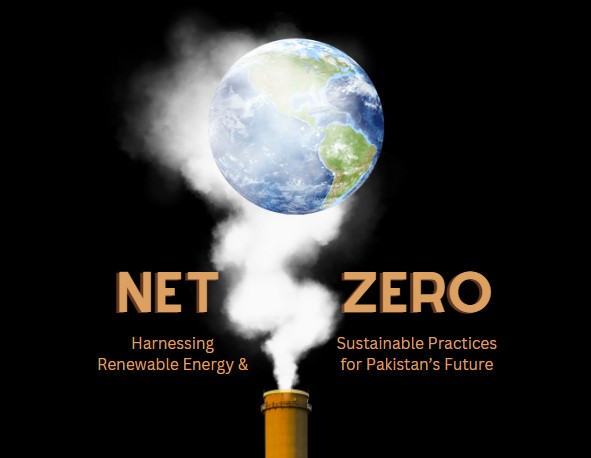As Pakistan stands at the precipice of a profound energy and environmental crisis, the path to a net-zero future is not only necessary but urgent. With decades of expertise in climate change mitigation, renewable energy, Eco Tourism, Eco friendly fashions and sustainable development, we are convinced that Pakistan has the potential to transform its energy landscape. This article ex-plores how leveraging renewable energy, pro-moting sustainable practices, and innovating in eco-tourism and eco-fashion can guide Pakistan towards achieving net-zero emissions.
The Energy Challenge: A Call for Transformation
Pakistan’s energy sector is facing severe challenges: high electricity costs, frequent power outages, and a heavy reliance on fossil fuels. These issues, coupled with increasing greenhouse gas emissions, necessitate a shift towards cleaner, more sustainable energy sources. Renewable energy offers a viable solution to these challenges, providing both environmental and socio-economic benefits.
Unlocking Renewable Energy Potential
Despite its vast potential, Pakistan’s adoption of renewable energy technologies remains limited. The country’s solar and wind resources offer significant opportunities for energy transformation. Learning from regional peers like Bangladesh and India, who have made substantial advances in solar energy, Pakistan can similarly harness these technologies to meet its energy needs sustainably.
Strategic Interventions for a Net-Zero Future
Drawing on our extensive experience in alternative energy and sustainable development, we propose a multifaceted approach to achieving net-zero emissions in Pakistan. This approach encompasses waste-to-energy solutions, expansion of solar and wind power, sustainable construction practices, and the promotion of eco-tourism and eco-fashion. Let’s explore how these elements can collectively contribute to Pakistan’s net-zero ambitions.
1. Waste-to-Energy: Turning Waste into Power
Waste-to-energy (WtE) technologies offer dual benefits: effective waste management and energy production. In Pakistan, where waste management poses a significant challenge, converting waste into energy presents a sustainable solution. Our work in developing technologies for biomass and waste conversion to energy through anaerobic digestion and biogas production illustrates the feasibility and advantages of WtE solutions.
Project Example: The Landhi Cattle Colony project in Karachi is a prime example of how organic waste can be transformed into biogas, providing clean energy and reducing environmental pollution. Similarly, producing methane gas from industrial effluents and other biomass materials through anaerobic digestion can serve as a clean alternative to natural gas.
Recommendation: Pakistan should invest in large-scale WtE plants and promote smaller, decentralized biogas systems in rural areas. This approach will manage waste effectively and provide a reliable energy source, reducing dependency on fossil fuels.
2. Solar and Wind Power: Tapping Into Natural Abundance
Pakistan is blessed with abundant sunlight and wind resources, especially in the Thar and coastal regions. Expanding solar and wind energy projects can significantly reduce the country’s carbon footprint and provide a stable energy supply.
Solar Power: Pakistan’s potential for solar energy is immense. Promoting large-scale solar parks and off-grid solutions, particularly for rural electrification, can harness this potential effectively. For example, the Quaid-e-Azam Solar Park in Punjab, though currently underutilized, exemplifies the possibilities of solar energy. With strategic investments and
policy support, similar projects can be expanded nationwide.
Wind Power: The wind corridors in Sindh and Balochistan offer substantial opportunities for wind energy generation. Encouraging investments in wind farms and integrating wind power into the national grid can diversify Pakistan’s energy mix, providing a cleaner alternative to coal and gas.
Recommendation: Implement policies that provide financial incentives, subsidies, and streamlined regulatory frameworks to attract investments in solar and wind energy projects.En- courage public-private partnerships to develop and expand renewable energy infrastructure.
3. Biomass to Energy: Utilizing Agricultural and Organic Waste
Pakistan’s agricultural sector produces significant amounts of biomass, which can be converted into energy. Technologies for transforming agricultural residues, animal waste, and other organic materials into biofuels and biogas can offer a sustainable energy source while addressing waste management issues.
Biomass Energy Projects: Our work on projects such as the development of biofuels from agricultural waste and the production of syngas from biomass, conversion of bagasse to energy etc. highlights the potential of these technologies. These initiatives not only provide renewable energy but also support rural development by creating local jobs and improving energy access.
Recommendation: Develop policies and incentives to promote the use of agricultural and organic waste for energy production. Support research and development in biomass conversion technologies and establish facilities for biofuel production.
4. Sustainable Construction: Building Eco-Friendly, Carbon-Neutral Structures
The construction sector is a major contributor to greenhouse gas emissions. Promoting ecofriendly, zero-energy, and carbon-neutral buildings is essential for reducing the sector’s environmental impact. Zero-Energy Buildings: As advocates for affordable zero-energy housing, our expertise in designing and constructing energy-efficient buildings can guide the development of sustainable urban infrastructure. These buildings utilize renewable energy technologies such as solar panels, geothermal heat pumps, and advanced insulation materials to achieve net-zero
energy consumption.
Geothermal and Ground Source Heat Pumps: Utilizing geothermal energy for heating and cooling can reduce reliance on traditional energy sources. Ground source heat pumps, which use the earth’s natural heat, are a sustainable solution for residential and commercial buildings.
Recommendation: Establish building codes and standards that mandate energy-efficient and carbon-neutral construction practices. Provide incentives for the adoption of renewable energy technologies in the construction of new buildings and retrofitting of existing structures.
5. Eco-Tourism: Promoting Sustainable Travel
Eco-tourism can play a pivotal role in achieving net-zero emissions by fostering sustainable travel practices and supporting conservation efforts. Pakistan’s diverse landscapes, from the towering peaks of the Himalayas to the serene coastal areas, offer tremendous potential for eco-tourism.
Promoting Eco-Friendly Destinations: Developing eco-friendly tourist destinations can minimize environmental impact while boosting local economies. Our experience in sustainable development and environmental protection can guide the creation of tourism initiatives that prioritize conservation and community engagement.
Community-Based Tourism: Encouraging community-based tourism can empower local populations and ensure that tourism benefits are distributed equitably. Sustainable practices, such as low-impact accommodations and eco-friendly transportation options, should be integral to these initiatives.
Recommendation: Develop national policies and frameworks that support eco-tourism. Provide training and resources to local communities to promote sustainable tourism practices. Ensure that tourism development aligns with conservation goals and minimizes environmental impact.
6. Eco-Fashion: Revolutionizing the Textile Industry
The fashion industry is a significant contributor to global emissions and environmental degradation. Promoting eco-fashion in Pakistan can reduce the industry’s carbon footprint and foster sustainable practices.
Sustainable Textile Production: Emphasizing the use of organic materials, environmentally friendly dyes, and sustainable manufacturing processes can transform Pakistan’s textile sector. My expertise in circular economy principles can guide the development of sustainable fashion practices that minimize waste and optimize resource use.
Upcycling and Recycling: Encouraging upcycling and recycling in fashion can reduce waste and extend the lifecycle of garments. This approach aligns with circular economy principles, promoting resource efficiency and reducing environmental impact.
Recommendation: Implement policies that incentivize sustainable practices in the textile industry. Support initiatives that promote eco-friendly materials and processes. Encourage consumer awareness and demand for sustainable fashion products.
Championing Circular and Blue Economies
Circular Economy: Integrating circular economy principles into Pakistan’s development model can minimize waste, enhance resource efficiency, and promote recycling. By transforming traditional linear models into sustainable, closed-loop systems, we can reduce environmental impact and foster economic resilience.
Blue Economy: Emphasizing sustainable use of ocean resources is vital for coastal and marine development. Our work in marine conservation and renewable energy generation from marine resources aligns with the principles of the blue economy. Initiatives such as the Landhi Cattle Colony marine pollution control project exemplify how sustainable practices can protect marine ecosystems and promote economic growth.
Recommendation: Promote policies and initiatives that support the circular and blue economies. Encourage industries to adopt sustainable practices that reduce waste and enhance resource efficiency.
Policy Recommendations for a Net-Zero Pakistan
1. Expand Renewable Energy Capacity: Develop a comprehensive national strategy to scale up solar, wind, and biomass energy projects. Foster public-private partnerships and international collaborations to finance and implement these projects.
2. Support Decentralized Energy Solutions: Encourage the adoption of rooftop solar systems, mini-grids, and off-grid solutions, particularly in underserved areas. Provide financial incentives and regulatory support to facilitate these initiatives.
3. Revise Subsidy Structures: Redirect subsidies towards supporting renewable energy projects and technologies, ensuring that benefits reach lower-income groups effectively.
4. Enhance Regulatory Frameworks: Streamline regulations to attract investments in renewable energy. Ensure that policies support innovation and private sector participation in the energy sector.
5. Promote Sustainable Construction: Establish building codes and standards that mandate energy-efficient and carbon-neutral construction practices. Provide incentives for the adoption of renewable technologies in the construction sector.
6. Foster Eco-Tourism and Eco-Fashion: Develop national policies to support sustainable tourism and fashion practices. Encourage community-based tourism and sustainable textile production to reduce environmental impact and promote local economic development.
7. Leverage International Partnerships: Engage proactively with global initiatives like the Just Energy Transition Partnership (JETP) to secure investments and technical support for renewable energy projects.
Achieving net-zero emissions represents a pivotal scientific and technological challenge that Pakistan is well-positioned to tackle with concerted efforts and strategic planning. Leveraging renewable energy technologies such as solar, wind, and hydro-electric power is fundamental. Scientific data from institutions like the International Renewable Energy Agency (IRENA) underscores Pakistan’s abundant renewable energy potential, particularly in solar energy, which could meet a significant portion of the country’s energy demand.
Implementing sustainable practices across in-dustries is equally imperative. Scientific studies indicate that adopting sustainable agriculture techniques not only enhances crop yields but also reduces carbon emissions by optimizing soil health and minimizing chemical inputs. Transitioning to electric vehicles and improving energy efficiency in manufacturing processes are crucial steps toward achieving net-zero emissions, backed by data showing substantial reductions in greenhouse gas emissions.
Together, let us embrace the challenge of achieving net-zero emissions, ensuring a sustainable legacy for future generations based on sound scientific principles and collaborative action.







